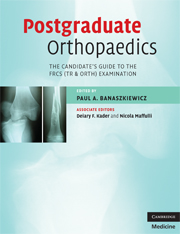Book contents
- Frontmatter
- Contents
- List of contributors
- Foreword by Mr Peter Gibson
- Preface
- Glossary
- Section 1 The FRCS (Tr & Orth) examination
- Section 2 The written paper
- Section 3 The clininicals
- Section 4 Adult elective orthopaedics oral
- Section 5 The hand oral
- Section 6 The paediatric oral
- Section 7 The trauma oral
- Section 8 The basic science oral
- Section 9 Miscellaneous topics
- 25 Candidates' accounts of the examination
- 26 Examination failure
- Index
26 - Examination failure
from Section 9 - Miscellaneous topics
Published online by Cambridge University Press: 22 August 2009
- Frontmatter
- Contents
- List of contributors
- Foreword by Mr Peter Gibson
- Preface
- Glossary
- Section 1 The FRCS (Tr & Orth) examination
- Section 2 The written paper
- Section 3 The clininicals
- Section 4 Adult elective orthopaedics oral
- Section 5 The hand oral
- Section 6 The paediatric oral
- Section 7 The trauma oral
- Section 8 The basic science oral
- Section 9 Miscellaneous topics
- 25 Candidates' accounts of the examination
- 26 Examination failure
- Index
Summary
By the law of averages some candidates will inevitably fail.
Introduction
We are informed that the FRCS Orth is not a competitive examination and that the pass rate is not set and will vary from examination to examination depending on the standard achieved. In recent years, the rate has varied between 55% and 78%. It may be stating the obvious, but the pass mark means that some candidates are going to fail. There has been an unconfirmed view from recent candidates that because of the changes of “3 attempts only in the clinicals and you are back at the beginning” the pass mark has gone up. “It is not in the examiners' interests to fail candidates unnecessarily.” The examiners, however, have a duty to protect the public and if there is any doubt whatsoever about a candidate, they are failed.
Prevention is better than cure
In our “candidates' accounts” section we offer many dialogues when the candidate knew they had performed badly and had blown it. This is to alert you to be on your guard for various pitfalls and hopefully avoid them.
That said during the examination do not under any circumstances assume that you have failed and give up – you have failed only when you have that piece of paper in your hand confirming this to be the case.
There is always going to be a small number of candidates who perform so poorly in the clinicals that they instinctively know they have failed.
- Type
- Chapter
- Information
- Postgraduate OrthopaedicsThe Candidate's Guide to the FRCS (TR & Orth) Examination, pp. 587 - 590Publisher: Cambridge University PressPrint publication year: 2008



